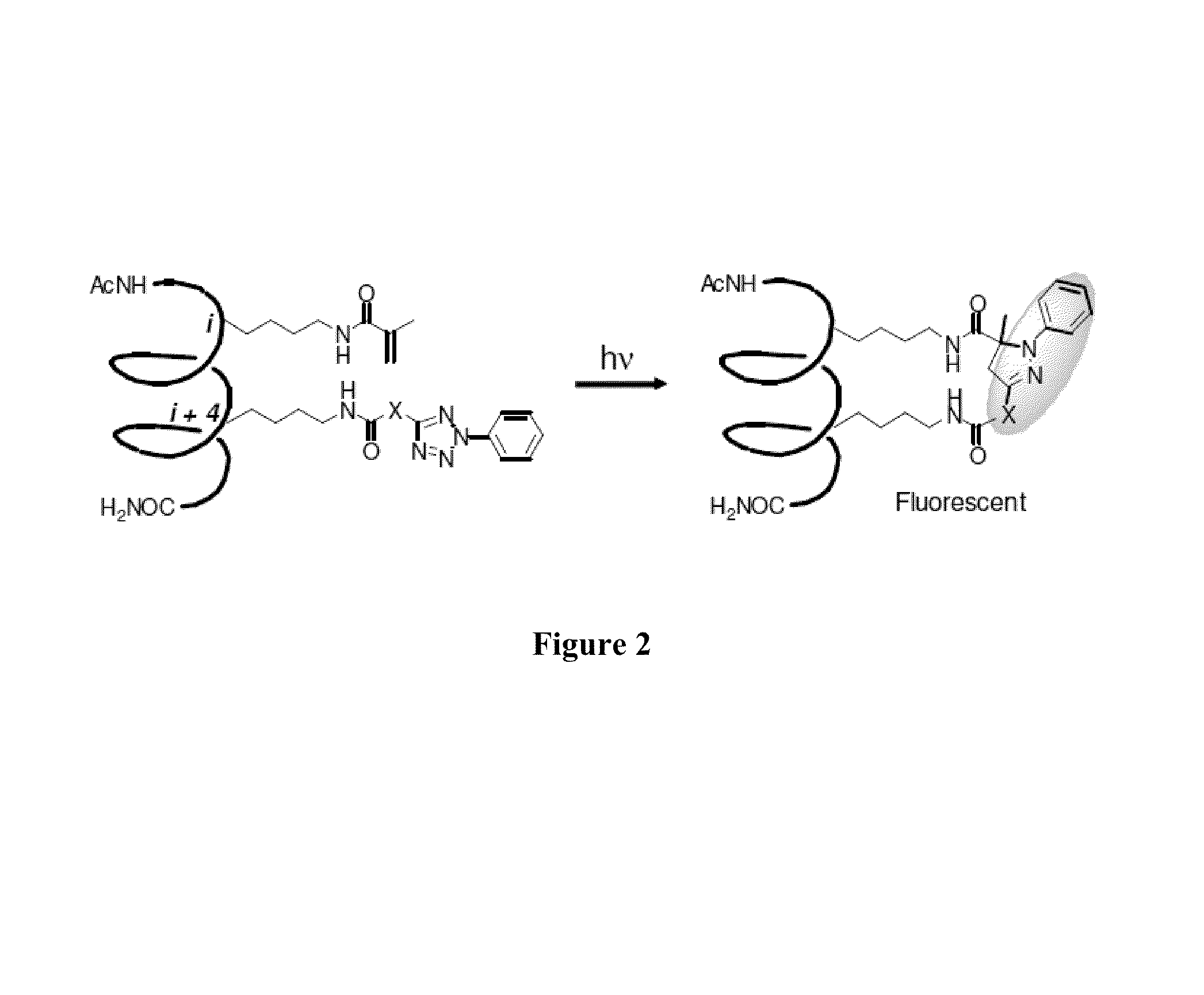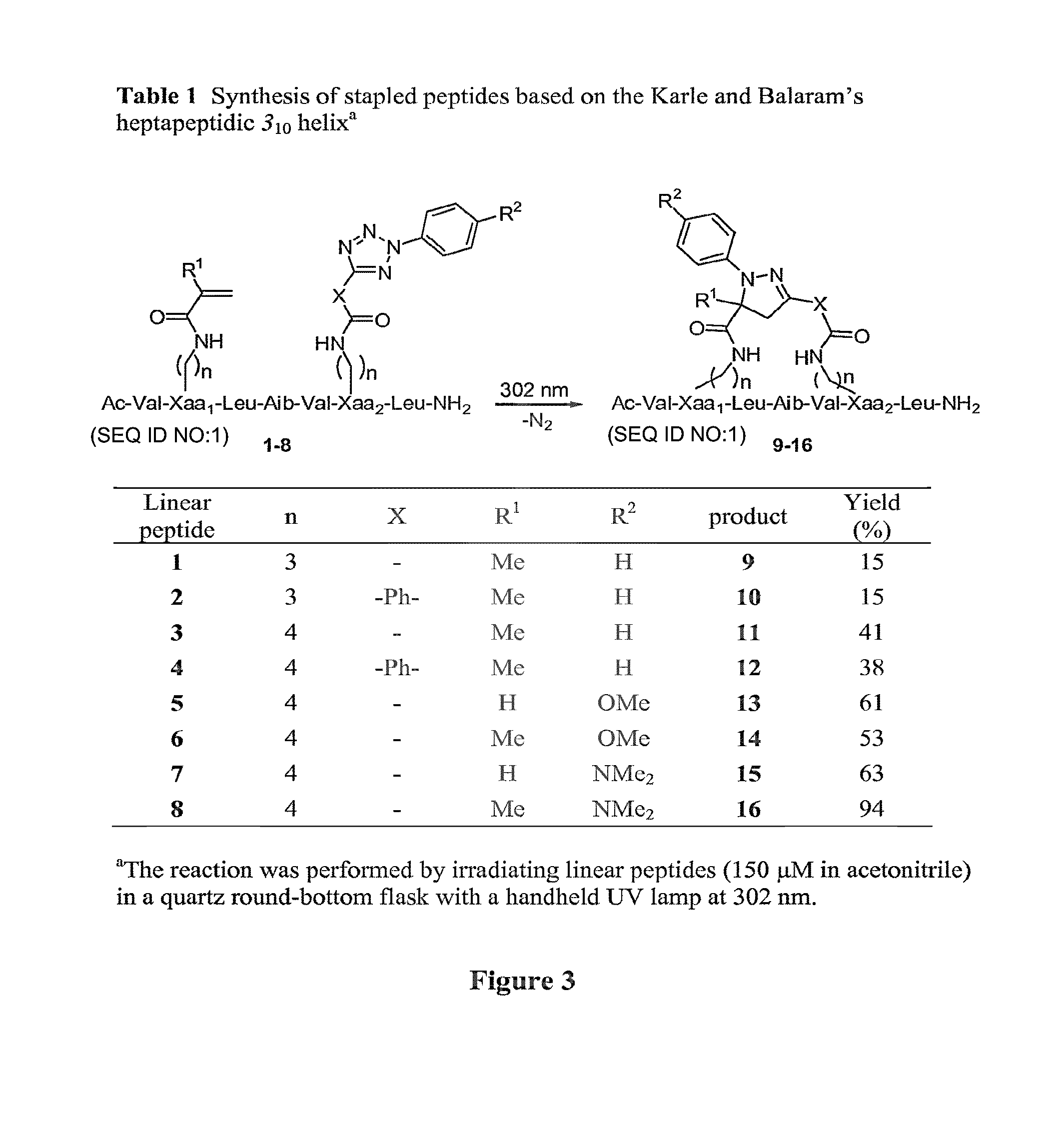Stapled peptides and method of synthesis
a technology of stapled peptides and synthesis methods, which is applied in the field of functionalized peptides, can solve the problems of reduced therapeutic potential, reduced biological activity, and few reactions to date that give rise to reasonable yields without, and achieve the effect of reasonable reaction yields
- Summary
- Abstract
- Description
- Claims
- Application Information
AI Technical Summary
Benefits of technology
Problems solved by technology
Method used
Image
Examples
example 1
[0067]One example of stapled peptide helices based on an intramolecular photoactivated, nitrile imine-mediated 1,3-dipolar cycloaddition reaction (“photoclick chemistry”) (FIG. 2) is discussed in the following.
[0068]We observed that the nitrile imine species, while reactive toward suitable alkenes, was exceedingly stable in the aqueous medium. To probe whether this unique reactivity profile can be harnessed to “staple” peptides, we appended an alkene and a tetrazole moiety, respectively, to peptide side chains located at the i and i+4 positions of Balaram's 310-helix (scheme in FIG. 3). We chose this peptide helix model because it has been studied previously by Grubbs and co-workers in demonstrating ruthenium-catalyzed ring closing metathesis chemistry for peptide stapling. We envisioned that upon photoirradiation, tetrazole would undergo the cycloreversion reaction to generate the nitrile imine dipole in situ, which would then react with a proximal alkene dipolarophile to form a fl...
example 2
[0125]Cellular Uptake Study: HeLa cells cultured on cover slips were treated with 100 μM of peptide 13 or control peptide 18 in 2% DMSO serum-free DMEM medium for 4 hr in a 37° C., 5% CO2 incubator. In preparation for fixation, medium was aspirated and the cells were washed twice with PBS. The cover slips were treated to a freshly prepared 4% paraformaldehyde / PBS solution for 10˜15 min, washed twice with PBS, and quenched with 50 mM NH4Cl for 10 minutes. After washing with PBS twice, the cover-slip was flipped and placed on top of microscopy glass containing in situ-frame and PBS buffer to make a sealed sample chamber. The images were acquired on a Zeiss Axioimager motorized fluorescence microscope. DAPI filter (ex 365 nm, em 445±25 nm) was used in acquiring fluorescence images. All image acquisitions and processing were performed under identical conditions.
example 3
Example of Peptide Synthesis and In Vitro Inhibition Study
[0126]GST-MDM2 and GST-MDMX containing full-length human MDM2 and MDMX and His6-tagged human p53 were expressed in Escherichia coli and affinity purified by binding to glutathione-agarose and Ni2+-nitrilotriacetic acid beads under non-denaturing conditions. ELISA plates were incubated with 2.5 μg / ml His6-p53 in phosphate-buffered saline (PBS) for 16 h. After washing with PBS+0.1% Tween 20 (PBST), the plates were blocked with PBS+5% nonfat dry milk+0.1% Tween 20 (PBSMT) for 0.5 hour. The peptides were dissolved in DMSO. GST-HDM2 and MDMX (5 μg / ml) were mixed with peptides in PBSMT+10% glycerol+10 mM dithiothreitol and added to the wells. The plates were washed with PBST after incubating for 1 hour at room temperature, incubated with MDM2 antibody 5B10 and MDMX antibody 8C6 in PBSMT for 1 hour, followed by washing and incubation with horseradish peroxidase-rabbit-anti-mouse Ig antibody for 1 hour. The plates were developed by i...
PUM
| Property | Measurement | Unit |
|---|---|---|
| wavelength | aaaaa | aaaaa |
| melting point | aaaaa | aaaaa |
| melting point | aaaaa | aaaaa |
Abstract
Description
Claims
Application Information
 Login to View More
Login to View More - R&D
- Intellectual Property
- Life Sciences
- Materials
- Tech Scout
- Unparalleled Data Quality
- Higher Quality Content
- 60% Fewer Hallucinations
Browse by: Latest US Patents, China's latest patents, Technical Efficacy Thesaurus, Application Domain, Technology Topic, Popular Technical Reports.
© 2025 PatSnap. All rights reserved.Legal|Privacy policy|Modern Slavery Act Transparency Statement|Sitemap|About US| Contact US: help@patsnap.com



